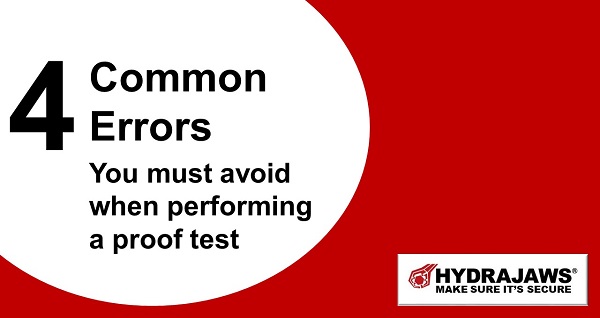Proof testing using Hydrajaws equipment is easy, straightforward and accurate when done correctly. In this article we have identified 4 common mistakes that you may be making that can affect test results and the methods to avoid them.
Incorrect use of the analogue gauge.
There are two main errors associated with using an analogue gauge.
The first is the incorrect use of the maximum load indicator (sometimes referred to as the drag needle). This should always be set to zero before any winding of the pull tester takes place. This will allow the maximum load achieved level to be indicated should the fixing fail before the desired load level is achieved.
The second is parallax error, where the reading is inaccurate due to the readers’ eye being positioned at an angle to the measurement markings. This error should not be overlooked, as the difference in readings could be the difference between a pass and a fail. It is worth noting that both of these errors don’t occur when using a digital gauge and the Bluetooth Digital System accurately records and produces a graph to show the maximum load achieved.
Incorrect positioning of the load bridge on brick or blockwork.
When the fixing to be tested is located in brick or blockwork then the load bridge feet of the pull tester should not be positioned on the same brick or block as the fixing being tested. Instead the load bridge feet should be positioned on the surrounding bricks that don’t have the fixing to be tested in them. It is worth noting that the original 150 Bridge was designed to give enough expanse across a UK house brick. When testing on blockwork, then a 270 or 600 load spreading bridge should be used.
Not understanding when ‘proof testing’ and ‘test to failure’ are appropriate.
The vast majority of pull testing is proof testing. This involves loading an anchor up to an appropriate level for an appropriate amount of time. This is designed to give all stakeholders greater confidence that the anchor chosen will hold the load required in the particular substrate. It is important that a suitable holding time is used. This is normally between 30 seconds and 3 minutes, depending on the application.
‘Test to failure’ is pulling an anchor until there is either a failure or the load limit of the pull test machine reaches its maximum rated load. As the name suggests, testing to failure is likely to cause damage to the substrate, which on many occasions will need repairing, which can be costly, both in time and money. ‘Test to failure’ should only be considered when there is no manufacturer data on the anchor being tested and the substrate in which the anchor is being used. The Construction Fixings Association has several guidance notes to discuss this in more detail.
Not testing to the appropriate load for the anchor and/or substrate and/or application.
The importance of researching the anchor/substrate and application before any pull testing takes place cannot be stressed enough. Prior specification information ensures that the relevant pull test regimes are chosen. The Hydrajaws Bluetooth Digital System ensures this information is recorded before the first pull test. It is important to note that when proof testing to a known safety factor over the calculated application load, the design resistance of the anchor must not be exceeded. The Construction Fixings Association has several guidance notes to discuss this in more detail.
Ensure you are not making these mistakes during a job and your results will be accurate and safe.
For more information the testing requirement of anchors is detailed in two British Standards:
BS 8539:2012 Code of practice for the selection and installation of post-installed anchors in concrete and masonry. BSI (see BSI website)
BS 7883:2019 Personal fall protection equipment. Anchor systems. System design, installation, and inspection. Code of practice. (see BSI website)
Hydrajaws offers training on both the safe use of a Hydrajaws Tester and delegates working towards relevant standard BS 7883:2019 and issuing certificates of competence that are recognised by local authorities and others in the industry. Further details can be found on the training page of our website Hydrajaws Training
The Construction Fixings Association runs training courses for General Purpose anchor testing to the recommendations of the CFA Guidance Note: Procedures for site testing construction fixings – 2012 and therefore to the recommendations of BS 8539:2012. For more information visit CFA Training
